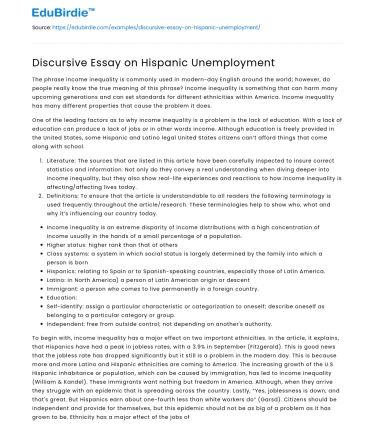Introduction
The issue of unemployment within the Hispanic community in the United States is a multifaceted phenomenon with deep-rooted causes and wide-ranging implications. As one of the fastest-growing demographic groups in the country, Hispanics have a significant impact on the national economy. However, their unemployment rates have often been higher than the national average, reflecting systemic challenges and barriers to employment. This essay explores the various dimensions of Hispanic unemployment, examining the socio-economic factors that contribute to this persistent issue and evaluating the policies aimed at reducing these disparities. By delving into real-life cases and statistical data, we aim to provide a comprehensive understanding of the current state of Hispanic unemployment and propose viable solutions to mitigate this challenge.
Socio-Economic Factors Contributing to Hispanic Unemployment
Hispanic unemployment cannot be fully understood without considering the socio-economic factors that play a crucial role in shaping employment outcomes. Educational attainment is a key determinant, as lower levels of education among Hispanics often limit access to higher-paying jobs. According to the U.S. Bureau of Labor Statistics, in 2020, only 20% of Hispanics aged 25 and older had a bachelor's degree or higher, compared to 36% of the overall population. This educational gap restricts opportunities for career advancement and contributes to higher unemployment rates within the community.
Save your time!
We can take care of your essay
- Proper editing and formatting
- Free revision, title page, and bibliography
- Flexible prices and money-back guarantee
Language barriers further exacerbate the situation, as proficiency in English is often a prerequisite for many jobs in the United States. Limited English skills can hinder job prospects and restrict access to training programs that could enhance employability. This linguistic challenge is particularly pronounced among first-generation immigrants, who may not have had access to English education in their country of origin. The Pew Research Center indicates that about 32% of Hispanic adults in the U.S. are not proficient in English, creating a significant barrier to employment.
Additionally, discrimination in the labor market remains a persistent issue. Despite legislation aimed at ensuring equality, Hispanic workers often face biases that can result in fewer job opportunities and lower wages. A study by the Economic Policy Institute found that Hispanic workers earn, on average, 74 cents for every dollar earned by their white counterparts, highlighting the wage disparity rooted in systemic discrimination. These socio-economic factors collectively contribute to the higher rates of unemployment experienced by the Hispanic community.
Policy Measures and Their Effectiveness
In response to the challenges faced by Hispanic workers, various policy measures have been implemented to improve employment outcomes. Workforce development programs, such as job training and education initiatives, aim to equip Hispanics with the skills needed for high-demand industries. For example, the Workforce Innovation and Opportunity Act (WIOA) provides funding for job training and adult education, targeting underserved communities, including Hispanics.
However, the effectiveness of these programs is often limited by insufficient funding and inadequate outreach. A report from the National Skills Coalition highlights that many Hispanics are unaware of available resources due to language barriers and a lack of targeted communication. Furthermore, the allocation of resources may not adequately address the specific needs of the Hispanic community, resulting in suboptimal outcomes.
Despite these challenges, some localized efforts have shown promise. Community-based organizations have played a crucial role in bridging the gap between Hispanics and employment resources. For instance, organizations like UnidosUS have developed tailored programs that focus on both skill development and overcoming language barriers. By creating culturally relevant initiatives, these organizations have successfully increased employment rates among participants, demonstrating the potential of targeted interventions.
Counter-Arguments and Broader Perspectives
While the aforementioned factors and policies highlight the challenges and efforts to address Hispanic unemployment, it is important to consider counter-arguments and broader perspectives. Some critics argue that the focus on socio-economic barriers may overlook personal responsibility and motivation as key determinants of employment outcomes. They posit that individual drive and adaptability play a significant role in overcoming obstacles, regardless of external challenges.
Moreover, there is a viewpoint that the influx of Hispanic immigrants might contribute to competition for low-skilled jobs, potentially affecting employment rates within the community. This perspective suggests that immigration reform, aimed at providing legal pathways for undocumented workers, could mitigate labor market competition and improve employment prospects for Hispanics. However, evidence on this matter remains mixed, with studies such as those by the National Bureau of Economic Research indicating that immigration has a negligible impact on native employment rates.
These counter-arguments underscore the complexity of Hispanic unemployment and the need for a nuanced approach that considers both individual and systemic factors. By acknowledging these perspectives, policymakers can develop more comprehensive strategies that balance personal agency with structural support.
Conclusion
In conclusion, Hispanic unemployment in the United States is a multifaceted issue influenced by a confluence of socio-economic factors, policy measures, and broader societal dynamics. Educational attainment, language proficiency, and discrimination remain significant barriers to employment for many Hispanics. While policy initiatives like workforce development programs offer potential solutions, their effectiveness is often hampered by inadequate resources and outreach. Counter-arguments emphasizing personal responsibility and immigration reform add further complexity to the discourse, highlighting the need for a balanced approach.
Ultimately, addressing Hispanic unemployment requires a concerted effort from policymakers, community organizations, and individuals. By fostering an inclusive labor market that acknowledges and addresses the unique challenges faced by Hispanics, the United States can work towards reducing unemployment disparities and promoting economic equity for all. Through continued dialogue and targeted action, the nation can harness the potential of its diverse workforce and pave the way for a more prosperous future.






 Stuck on your essay?
Stuck on your essay?

